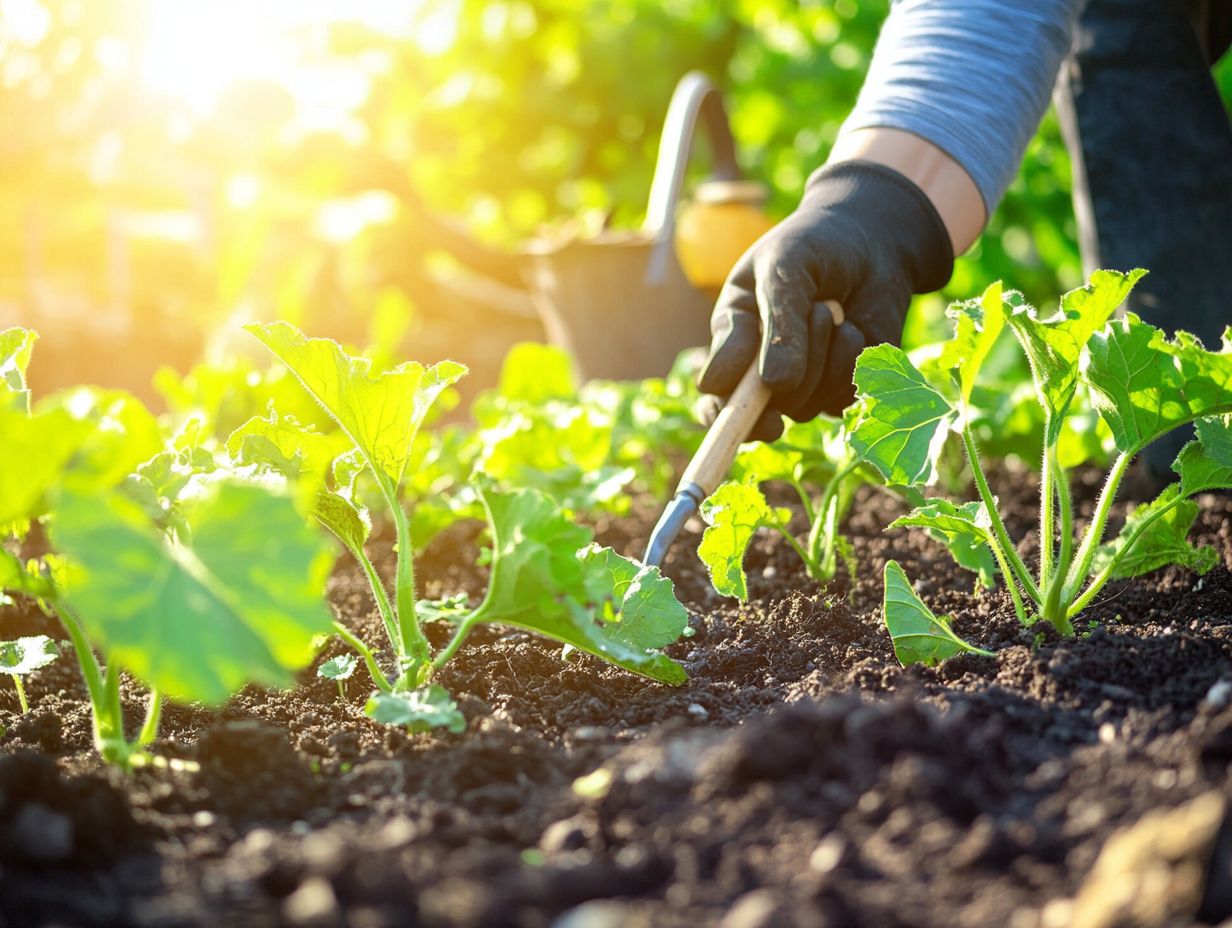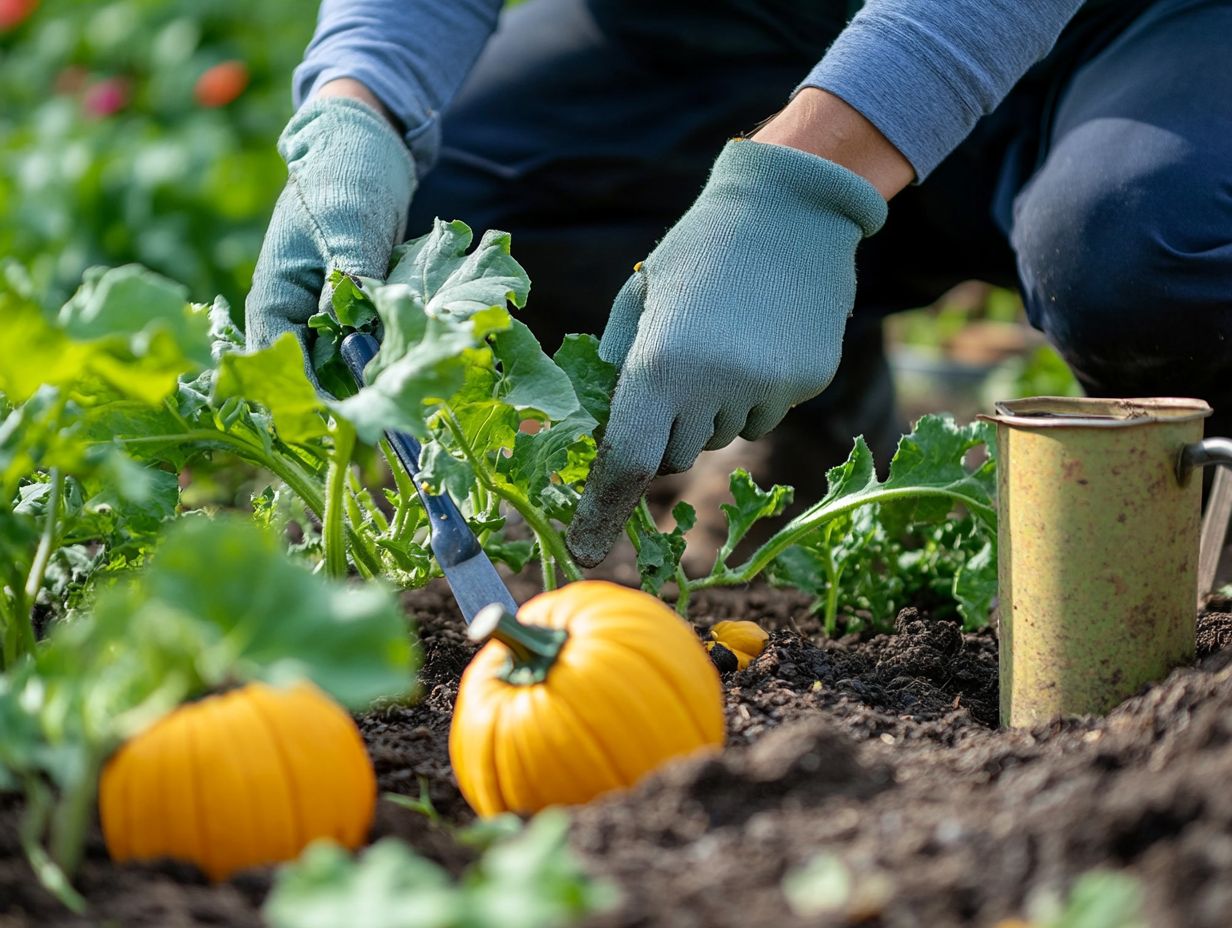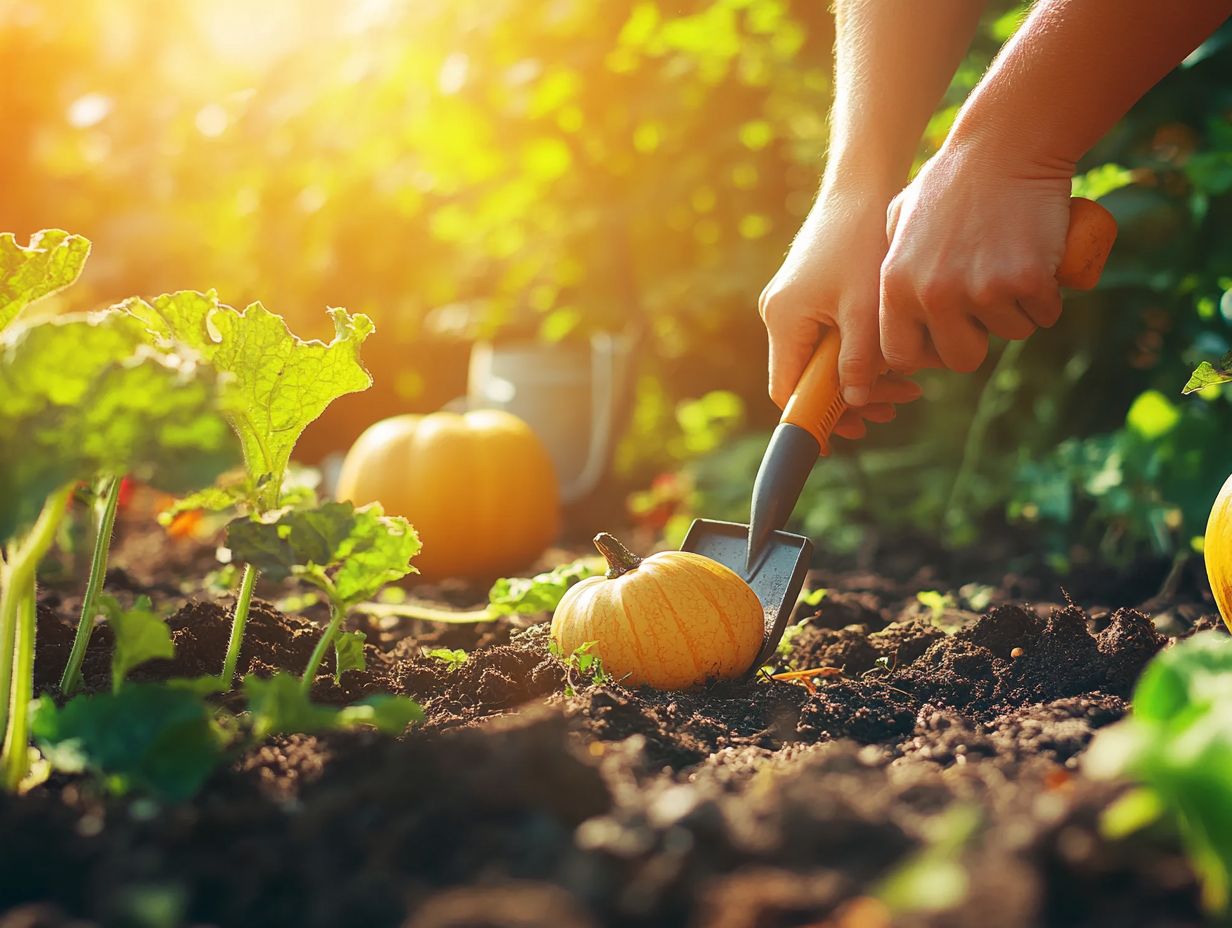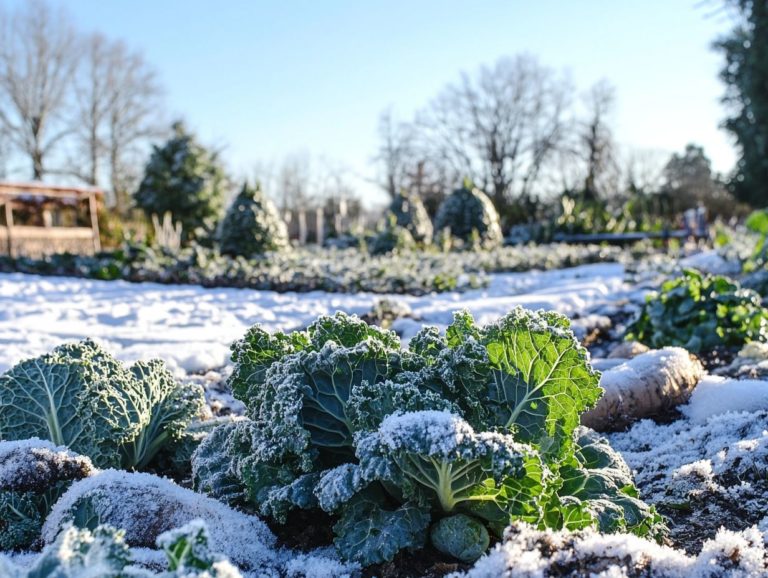How to Plant and Care for Winter Squash
Winter squash is a remarkable and nutritious addition to your garden, bringing vibrant colors and unique shapes along with a wealth of culinary possibilities.
Discover how to pick the ideal spot for planting! This guide will walk you through the essentials of planting and nurturing winter squash. You ll learn to choose the perfect planting site, understand the soil and sunlight requirements, and follow step-by-step planting instructions to ensure these hardy plants thrive.
You ll also dive into important topics like watering, fertilizing tips, effective pest management, and best practices for harvesting and storing your squash to maximize its flavor. Prepare to discover delicious recipes that showcase winter squash in innovative and delightful ways. Get excited to transform your garden and kitchen into a culinary wonderland!
Contents
- Key Takeaways:
- Types of Winter Squash
- Choosing and Preparing the Planting Site
- Planting Winter Squash
- Caring for Winter Squash Plants
- Harvesting and Storing Winter Squash
- Delicious Recipes Using Winter Squash
- Frequently Asked Questions
- 1. How do I prepare the soil for planting winter squash?
- 2. When is the best time to plant winter squash?
- 3. How deep should I plant winter squash seeds?
- 4. Do I need to fertilize my winter squash plants?
- 5. How often should I water my winter squash plants?
- 6. When is the best time to harvest winter squash?
Key Takeaways:

- Choose a sunny spot with well-drained soil to plant winter squash. Provide regular watering and fertilizing to support healthy growth.
- Plant winter squash seeds or transplants directly in the ground. Keep plants well-watered and fertilized to promote strong roots and ample fruit production.
- Harvest winter squash when fully mature and store it in a cool, dry place. Get creative with winter squash in the kitchen with these delicious recipes.
Types of Winter Squash
Winter squash presents a remarkable variety of options, including the beloved butternut squash, delicata squash, spaghetti squash, and acorn squash.
Each variety belongs to the Cucurbita genus (the family of squash plants) and brings its own distinct flavors, textures, and culinary uses to the table, making them essential during the fall harvest.
By familiarizing yourself with these diverse types, you can elevate your vegetable gardening experience and embark on a more rewarding culinary adventure.
Choosing and Preparing the Planting Site
Selecting the ideal planting site is essential for achieving success in winter squash cultivation. This vibrant crop demands soil that is rich in nutrients and plenty of sunlight to truly thrive.
Diligently preparing the soil is essential for success. Thoughtfully consider amendments and practice careful crop rotation planning to set the stage for your winter squash to flourish throughout the growing season.
Soil Requirements and Sunlight Needs
The soil requirements for cultivating winter squash, particularly Cucurbita spp., are quite important. These plants flourish in garden soil that is rich in nutrients and organic matter, and they demand at least six hours of direct sunlight each day.
To ensure optimal growth, conducting soil testing is crucial. This will provide you with valuable information on pH levels and any nutrient deficiencies. Winter squash thrives in a slightly acidic to neutral pH range of 6.0 to 7.0. If your test reveals that amendments are needed, you can raise the pH by adding lime or lower it with sulfur, depending on the situation.
Choosing a location that basks in ample sunlight not only promotes healthy growth but also enhances fruit development. When positioning your plants, look for areas that are sheltered from harsh winds and feature good drainage. These factors will significantly impact the vitality of your winter squash.
Planting Winter Squash
When you decide to plant winter squash, it s crucial to choose your seed types thoughtfully and employ effective seed propagation methods to promote robust plant growth.
Adhering to specific planting recommendations, such as maintaining the right spacing between plants, will be essential in reducing pest issues and maximizing your yields.
Step-by-Step Planting Instructions

Planting winter squash can be simple! Follow these step-by-step instructions for seed propagation and essential planting tips for healthy growth.
- Begin with soil preparation; ensure your ground is rich, well-drained, and enriched with organic matter.
- Testing the soil pH which indicates how acidic or basic the soil is aim for a neutral range of 6.0 to 7.0 for optimal squash development.
- Timing is crucial late spring is your sweet spot when soil temperatures reach at least 70 F.
- Regarding sowing seeds, plant them about one inch deep and space them 24 to 36 inches apart, giving those sprawling vines plenty of room to flourish.
Consider using techniques like creating hills or mounds to improve drainage and warmth. This approach will also help you avoid common pitfalls like overcrowding, which can stifle air circulation and invite diseases. With these strategies in hand, you re well on your way to a bountiful winter squash harvest!
Caring for Winter Squash Plants
Caring for winter squash plants demands attention to key aspects like watering, fertilization, and pest control to secure a healthy and abundant harvest.
By grasping common watering mistakes and embracing organic fertilizers, you can significantly elevate your winter squash care regimen.
Watering and Fertilizing Tips
Effective watering and fertilizing are vital for your winter squash care, as improper practices can lead to growth issues and less-than-ideal yields.
Water deeply, but not too often. Let the soil dry out a bit between waterings to encourage strong roots. Typically, you should provide about 1 to 1.5 inches of water per week, adjusting based on your specific climate and soil type. Pair this with organic fertilizers like compost or well-rotted manure to significantly enhance soil health and promote vigorous plant growth.
Be cautious to avoid overwatering, as this can result in root rot and other serious problems, jeopardizing your chances for a fruitful harvest!
Common Pests and Diseases to Watch Out For
When growing winter squash, it s essential to remain vigilant about common pests and diseases that can impact your plants, such as squash bugs and other related issues.
These challenges can result in significant crop loss if not addressed promptly and effectively. You may notice signs of pest infestations or diseases manifesting in various ways, from wilting leaves to unusual discoloration. Early identification is key; the sooner you spot these issues, the greater your chances for successful intervention.
By implementing preventative measures like crop rotation and maintaining proper sanitation practices, you can significantly reduce the risk of these threats taking hold.
Your treatment options may include organic insecticides, companion planting, and ensuring optimal soil health to foster robust plant growth and resilience.
Harvesting and Storing Winter Squash
Harvesting and storing winter squash lets you enjoy the fruits of your labor! This is especially true during the fall harvest when the squash reaches its peak ripeness and flavor. Embrace this moment to savor the true essence of your efforts.
When to Harvest and How to Store

Timing is everything! Pick your squash at just the right moment for the best flavor! Knowing when to harvest winter squash is key to ensuring top-notch quality, and mastering proper storage techniques will help preserve that delightful flavor long after the fall harvest.
The optimal moment to pick varies across different varieties. Generally, most winter squash, such as butternut or acorn, should be harvested when the skin feels hard and you can’t easily puncture it with your fingernail. Watch the stem, too it should be dry and corky when it s time to pick.
Curing them is a great idea! For better storage longevity, cure them in a warm, dry place for a couple of weeks. Once they’re ready for storage, place them in a cool, dark area with good ventilation. This approach will help prevent spoilage and keep their flavors intact for months to come.
Delicious Recipes Using Winter Squash
Delicious recipes featuring winter squash can elevate this versatile vegetable into a realm of flavorful dishes.
These recipes highlight the edible flesh of winter squash through a variety of cooking methods and fun ideas.
Creative Ways to Cook and Enjoy Winter Squash
Discover how to cook and enjoy winter squash! From roasting to pureeing, each method showcases its natural sweetness.
These adaptable vegetables transform into hearty soups or vibrant side dishes. Just picture making creamy bisque or adding cubed squash to your salads!
Winter squash pairs well with herbs like sage and thyme. Its health benefits include vitamins A and C, fiber, and antioxidants, which help protect your body from damage.
Frequently Asked Questions
1. How do I prepare the soil for planting winter squash?
Start by choosing a sunny spot with well-draining soil. Clear away weeds and debris, then loosen the soil to at least 6 inches deep.
2. When is the best time to plant winter squash?

Plant winter squash after the last frost, usually in late spring or early summer. In warmer climates, you can also plant in late summer for a fall harvest.
3. How deep should I plant winter squash seeds?
Plant seeds about 1 inch deep. Space them 2-3 feet apart for proper growth.
4. Do I need to fertilize my winter squash plants?
Yes, regular fertilization helps! Use a balanced fertilizer once a month or add compost around the plants.
5. How often should I water my winter squash plants?
Water deeply once a week, soaking the soil to at least 6 inches. Mulching can help retain moisture and reduce weeds.
6. When is the best time to harvest winter squash?
Harvest when the fruit is mature, the skin is hard, and the vine dies back. Cut the squash from the vine, leaving a few inches of stem, and store in a cool, dry place.






